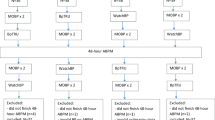Abstract
Ambulatory blood pressure monitoring (ABPM) is commonly used to diagnose pediatric hypertension. Using ABPM, hypertension is usually defined as a mean BP greater than the 95th percentile for height. A BP load >30% (% of BP readings greater than the 95th percentile) is also used for the diagnosis of hypertension. The objective of this study was to determine the agreement between mean BP greater than the 95th percentile and 30% BP load for the diagnosis of hypertension using ABPM. All ABPM records (n =1,009) of patients referred for hypertension to a pediatric center were retrieved. Scans were excluded if: age was >19 and height <115 cm or >185 cm. Mean BP and BP loads were calculated for 728 scans. Agreement between mean BP greater than the 95th percentile for height and various BP loads were calculated using the kappa coefficient. The kappa coefficient of agreement between mean BP greater than the 95th percentile and 30% BP load was 0.56 and 0.57 for daytime systolic and diastolic BP, respectively. The agreement between mean night-time BP greater than the 95th percentile and 30% BP load was 0.70 and 0.66 for systolic and diastolic BP, respectively. Agreement between mean BP greater than the 95th percentile and 30% BP load is only moderate to good. Maximum agreement between mean BP greater than the 95th percentile and BP load is achieved at 50% BP load.
Similar content being viewed by others
References
National High Blood Pressure Education Program Working Group on High Blood Pressure in Children and Adolescents (2004) The fourth report on the diagnosis, evaluation, and treatment of high blood pressure in children and adolescents. Pediatrics 114:555–576
Sorof J, Portman R (2000) White coat hypertension in children with elevated blood pressure. J Pediatr 137:493–497
Soergel M, Kirschstein M, Busch C, Danne T, Gellermann J, Holl R, Krull F, Reichert H, Reusz GS, Rascher W (1997) Oscillometric 24-h ambulatory blood pressure values in healthy children and adolescents: a multicenter trial including 1,141 subjects. J Pediatr 130:178–184
Patzer L, Seeman T, Luck C, Wuhl E, Janda J, Misselwitz J (2003) Day and night time blood pressure elevation in children with higher grades of renal scarring. J Pediatr 142:117–122
Wuhl E, Witte K, Soergel M, Mehls O, Schaefer F (2002) Distribution of 24-h ambulatory blood pressure in children: normalized reference values and role of body dimensions. J Hypertens 20:1995–2007
Nehal US, Ingelfinger JR (2002) Pediatric hypertension: recent literature. Curr Opin Pediatr 14:189–196
Landis JR, Koch GG (1977) The measurement of observer agreement for categorical data. Biometrics 33:59–174
Mule G, Nardi E, Andronico G, Cottone S, Raspanti F, Piazza G, Volpe V, Ferrara D, Cerasola G (2001) Relationships between 24-h blood pressure load and target organ damage in patients with mild-to-moderate essential hypertension. Blood Press Monitor 6:15–23
Tsioufis C, Stefanadis C, Goumas G, Pitsavos C, Toutouzas P (1999) Relation of ambulatory blood pressure load with left ventricular geometry in untreated patients with mild-to-moderate hypertension. J Hum Hypertens 13:677–682
Bauwens F, Duprez D, De Buyzere M, Clement DL (1992) Blood pressure load determines left ventricular mass in essential hypertension. Int J Cardiol 34:335–338
Sorof JM, Cardwell G, Franco K, Portman RJ (2002) Ambulatory blood pressure and left ventricular mass index in hypertensive children. Hypertension 39:903–908
Flynn JT (2002) Differentiation between primary and secondary hypertension in children using ambulatory blood pressure monitoring. Pediatrics 110:89–93
Author information
Authors and Affiliations
Corresponding author
Rights and permissions
About this article
Cite this article
Koshy, S., Macarthur, C., Luthra, S. et al. Ambulatory blood pressure monitoring: mean blood pressure and blood pressure load. Pediatr Nephrol 20, 1484–1486 (2005). https://doi.org/10.1007/s00467-005-2014-6
Received:
Revised:
Accepted:
Published:
Issue Date:
DOI: https://doi.org/10.1007/s00467-005-2014-6




